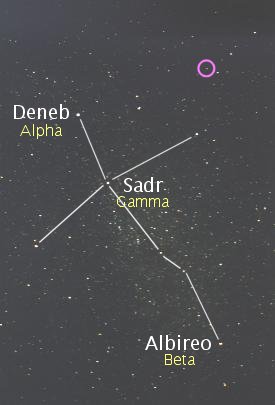

THE PLANETThe circle shows the location of the class G double star 16 Cygni (in the constellation Cygnus). A small telescope shows a pair of stars 39 seconds of arc apart. The planet, one of the few to known to orbit within a binary system, belongs to the fainter of the two, 16 Cygni-B. With a mass at least 1.68 times that of Jupiter, the planet orbits 16 Cygni-B at a distance that averages 1.68 astronomical units (12 percent farther than Mars is from the Sun) with a period of 800 days, or 2.2 years. The orbit is quite eccentric, however; the planet comes as close as 0.52 astronomical units to the star (72 percent Venus's distance from the Sun) and then goes as far away as 2.8 astronomical units, a bit over half Jupiter's distance from the Sun. From 16 Cygni-B's planet system (and no one knows if there are any "earths"), the somewhat brighter component, 16 Cygni-A, would shine with the brilliance of our full Moon. |